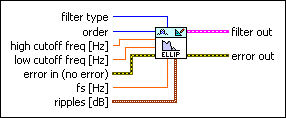DFD Elliptic Design VI
Owning Palette: Advanced IIR Filter Design VIs
Installed With: Digital Filter Design Toolkit
Creates a digital Elliptic infinite impulse response (IIR) filter.
You can use the DFD Elliptic Order Estimation VI to estimate order.

 Place on the block diagram Place on the block diagram |  Find on the Functions palette Find on the Functions palette |
 | filter type specifies the type of filter that this VI creates.
| ||||||||
 | order specifies the digital filter order. The value of order must be greater than zero. The default is 2. If you set filter type to Lowpass or Highpass, the digital filter order you specify must equal the analog prototype filter order. If you set filter type to Bandstop or Bandpass, the digital filter order you specify must be an even number that equals two times the analog prototype filter order. Increasing the value can narrow the transition band. | ||||||||
 | high cutoff freq specifies the high cutoff frequency in hertz. The value must be greater than low cutoff freq. The default is 0.45. This VI uses this input only for bandpass and bandstop filter design. The cutoff frequency that you specify corresponds to the edge frequency of the passband. | ||||||||
 | low cutoff freq specifies the low cutoff frequency in hertz. The default is 0.12. The cutoff frequency that you specify corresponds to the edge frequency of the passband. | ||||||||
 | error in describes error conditions that occur before this VI or function runs.
The default is no error. If an error occurred before this VI or function runs, the VI or function passes the error in value to error out. This VI or function runs normally only if no error occurred before this VI or function runs. If an error occurs while this VI or function runs, it runs normally and sets its own error status in error out. Use the Simple Error Handler or General Error Handler VIs to display the description of the error code. Use error in and error out to check errors and to specify execution order by wiring error out from one node to error in of the next node.
| ||||||||
 | fs specifies the sampling frequency in hertz. The value must be greater than zero. The default is 1, which is the normalized sampling frequency. | ||||||||
 | ripples specifies the passband ripple and stopband attenuation of the filter in decibels.
| ||||||||
 | filter out returns a new filter. | ||||||||
 | error out contains error information. If error in indicates that an error occurred before this VI or function ran, error out contains the same error information. Otherwise, it describes the error status that this VI or function produces.
Right-click the error out front panel indicator and select Explain Error from the shortcut menu for more information about the error.
|
DFD Elliptic Design Details
Elliptic filters have the following characteristics:
- Minimum peak error in the passband and stopband.
- Equi-ripple magnitude response in the passband and stopband.
- Compared with same-order Butterworth or Chebyshev filters, Elliptic filters have the sharpest transition band, which accounts for their widespread use.
Examples
Refer to the following VIs for examples of using the DFD Elliptic Design VI:




